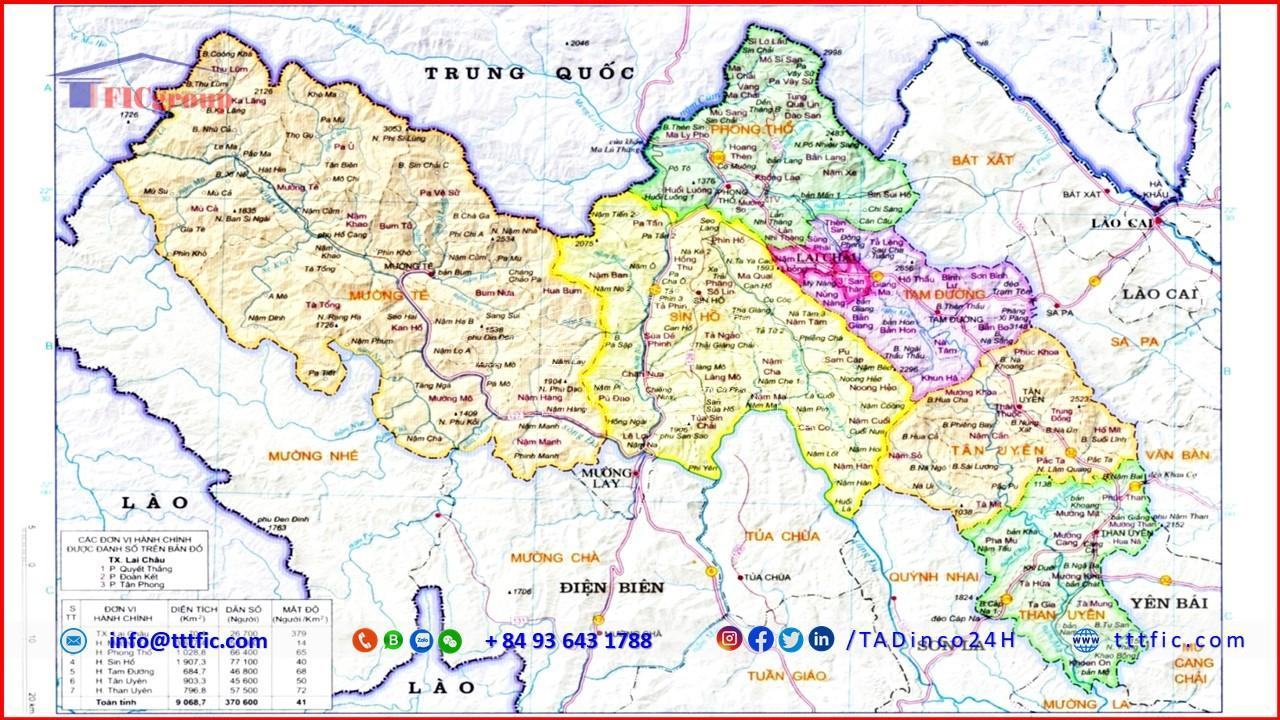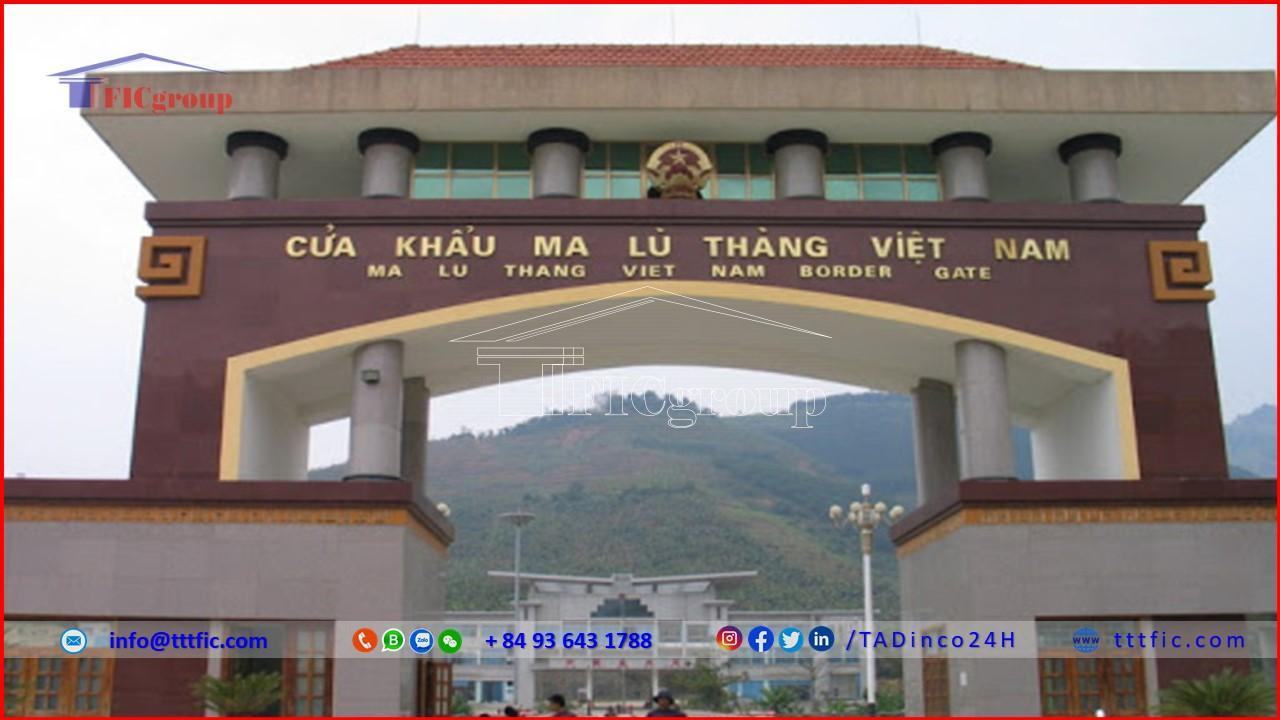
Industrial Zones in Lai Chau Province
- Investor: Lai Chau Provincial Industrial Zone Management Board
- Price: $25 usd/m2
- Area: 200 Ha
Lai Chau province is located in the Northwest region of Vietnam and is one of the beautiful and appealing mountainous provinces. With its stunning natural landscapes, Lai Chau attracts tourists with its high plateaus, forests, waterfalls, and enchanting rivers and streams. The province is also renowned for its diverse ethnic cultures, with over 20 ethnic groups residing and preserving their unique cultural traditions.
Furthermore, Lai Chau is blessed with abundant mineral resources and potential for hydropower development from hydroelectric projects. With improving infrastructure and transportation, visitors can easily access and explore the province’s natural beauty and cultural richness.
Overall, Lai Chau is an attractive destination for those who love to explore pristine nature, experience diverse ethnic cultures, and learn about the lives of people in the mountainous region of Vietnam.
Lai Chau is located in the Northwest, bordering the provinces of Son La (South), Dien Bien and Lao Cai (Northwest), and Yen Bai and Lao Cai (East and Southeast). The province has a natural area of 9,068.78 km².
Lai Chau has a tropical climate with distinct dry and rainy seasons. The rainy season is concentrated in June, July, and August, with an average annual rainfall of about 2,500 – 2,700mm. The dry season lasts from November to March of the following year with low rainfall. The average annual temperature is 22 – 25°C.
Lai Chau has many mountain ranges and plateaus. It is home to the highest peak in Indochina, Mount Fansipan, which is 3,143m high, and Pu Sam Cap, which is 1,700m high. Over 60% of the area has an altitude of over 1,000m, and over 90% has a slope greater than 25°C. There are numerous valleys, rivers, waterfalls, and hydropower potential.

lai-chau-province-tttfic-group
Forests and forested land cover 35% of Lai Chau’s natural area. There are many valuable timber and medicinal plant species of high economic value. In addition, the province is home to rare and endangered animal species such as rhinoceros, gaur, monkey, tiger, peafowl, and bear.
Lai Chau is located in the upper stream of the Da River with a high density of rivers and streams. There are many rivers and streams with large water flows such as Nam Na River, Nam Ma River, and Nam Mu River. Surface water also plays an important role in production and hydropower development.
Lai Chau has over 120 diverse mineral deposits, including rare earth minerals, non-ferrous metal ores (copper, lead, zinc), iron ores, copper ores, aluminum ores, and gold. Additionally, there are construction materials such as roofing stones, limestone, and white stones, along with mineral water sources.
Lai Chau attracts tourists with its beautiful caves, challenging mountain passes, waterfalls, and the cultural beauty of ethnic minorities like the Phong Tho dance. With its pristine landscapes and stunning clouds, Lai Chau offers a unique tourism experience.
Lai Chau has an extensive transportation network, including the Vietnam-China border road, Ma Lu Thang border gate, and national highways 4D, 70, and 32. This location also has potential for service, commercial, import-export, and tourism development. Lai Chau’s strategic position in protecting the national border is crucial, especially with large hydropower projects on the Da River and the Red River basin.
The province projects a decrease of 6.32% in the estimated Gross Regional Domestic Product (GRDP) for the first six months of 2023 (at constant 2010 prices), reaching 5,802,769 billion VND.
In the first half of 2023, the agriculture, forestry, and fisheries sector contributed 14.05% to GRDP. The industry and construction sector accounted for 34.34% of GRDP during the same period. The service sector made up 44.86% of GRDP for the first six months of 2023. Product taxes minus subsidies represented 6.75% of GRDP in this period (compared to 6.85% in 2022).

lai-chau-province-tttfic-group
In recent years, agriculture in Lai Chau has experienced significant growth and achieved notable accomplishments. The production value in 2020 reached over 3,200 billion VND, an increase of 8.5 times compared to 2004. The average annual growth rate of the agricultural sector from 2004 to 2020 was over 22%.
Crop cultivation:
Lai Chau has developed and expanded large-scale production areas for various commodities, such as over 8,000 hectares of tea, nearly 13,000 hectares of rubber, over 5,000 hectares of cassava, and 4,000 hectares of bananas. The One Commune One Product (OCOP) program has been promoted with 106 OCOP products. Livestock farming has shown good growth, with an increasing number of large-scale livestock farming models.
Livestock farming:
The province currently has 8 livestock farms, 10 Livestock Cooperative Groups (LCGs), and 4 livestock enterprises (mainly pig farming with a scale of 2,000-4,000 pigs per litter). There are approximately 45,050 households raising cattle and buffaloes, 43,150 households raising pigs, and 90,900 households raising poultry (including over 240 establishments with a scale of 15 cattle, horses, or 50 pigs, goats, or 500 poultry, or 300 rabbits and above).
Lai Chau aims to maintain an average annual growth rate of over 5% and reach 389,600 livestock by 2025, including 96,750 buffaloes, 20,350 cows, 272,500 pigs, and 1,850 thousand poultry.
By 2025, the province plans to have more than 36 cattle and buffalo farms, 28 pig farms, 12 goat farms, 6 concentrated horse farms, 760 beehives with a total of over 4,380 beehives in 17 establishments, and 6 rabbit farms with a focus on production. Additionally, 2 poultry breeding facilities will be established.
With a natural area of over 9,000 km2, Lai Chau is a vulnerable source protection area at the headwaters of the Da River, with a forest area of 479,538 hectares, including nearly 445,600 hectares of natural forests, with a forest coverage rate of over 51%.
The annual growth rate of forestry production value is expected to reach 5.0-5.5%. It is projected that the export value of wood and non-timber forest products will reach approximately 20 billion USD by 2025, with non-timber forest products accounting for over 1.5 billion USD. The focus will be on deep processing and high-value-added export of wood and forest products.
From 2004 to 2020, the overall industrial sector of the province experienced significant growth, with an average annual growth rate of 35.46% during the period 2004-2018. The total value of industrial products in 2018 (at 2010 price comparison) reached 4,726.11 billion VND.
The internal structure of the industrial sector shifted towards an increased proportion of electricity and gas production and distribution, while the proportion of mining industry decreased. In 2019, the province had 1,738 operating industrial establishments, and the number of workers in the industry grew rapidly, reaching 5,836 people in 2018. The average productivity of the entire industry was 32.5 million VND per person per year.
The province’s estimated GRDP growth rate is 9.15%, surpassing the planned 7.7%. The industrial and construction sectors are expected to increase by 15.6%.
The services sector is projected to grow by 5.61%. In 2022, the province aims to achieve a production value of 7,111.8 billion VND. This represents a 7.7% increase compared to the estimated performance in 2021.
According to the development targets for 2030 and the vision for 2045 of Lai Chau province, the estimated annual growth rate of the GRDP in the region is around 6-7%. The economic structure is expected to divide into agriculture, forestry, and fishery, industry, construction, and services, as well as import-export taxes, with proportions of 10%, 50%, and 40% respectively. The average per capita GRDP is projected to reach 65 million VND per year.
The province will focus on four key industries. These industries have potential, advantages, and a direction for continued development. The industries are: general industry, mineral extraction and deep processing, construction material production, and agricultural and forestry processing, and animal feed processing.

lai-chau-province-tttfic-group
In 2023, the city has 4,022 commercial and service establishments. These include 492 enterprises and cooperatives, as well as 3,530 individual businesses and household businesses. They mainly operate in sectors such as restaurants, hotels, transportation services, and grocery stores.
The estimated total retail sales of goods and consumer service revenue in 2022 is 3,454.4 billion VND. This amount represents 100% of the plan and indicates a 5% increase compared to 2021. The estimated number of tourists visiting the area in 2022 is 125,414 people. This figure shows an increase of 55,164 people compared to 2021. The estimated tourism revenue in 2022 is 165.4 billion VND. This amount exceeds the plan by 123.62% and reflects a 186.26% increase compared to 2021.
Many families actively participate in commercial and service tourism activities, earning hundreds of millions of VND per year, thereby continuously improving their material and spiritual life.
The total value of import and export goods in the province is estimated at 27.5 million USD. This accounts for 71.87% of the annual plan and represents a 42.30% increase from last year. The value of exported goods reached 8.5 million USD, equivalent to 69.88% of the annual plan. This marks a significant increase of 79.45% compared to the same period last year.
Local goods reached 3.4 million USD, 40.87% of the annual plan, a 9.32% increase from last year. Tea products were the main exports. Imported goods amounted to 19.0 million USD, 72.80% of the annual plan, a 30.23% increase from last year. Hydropower equipment constituted the main imports.
During the first 6 months of 2023, businesses registered 60 new companies with a total registered capital of 1,347.2 billion VND, which is equal to 38.7% of the plan. This marks a decrease of 27 businesses compared to the same period last year. The total number of businesses in the province reached 1,921, including 1,406 tax-declared businesses and 47 businesses temporarily suspended, with 8 businesses dissolved.
Thirteen cooperative unions were established, equal to 43.3% of the plan, an increase of 7 unions compared to the same period last year. Currently, there are 416 cooperative unions in the province, including 326 active in production and business and 90 temporarily inactive.
The authorities approved twelve investment projects with a registered capital of 2,660 billion VND, indicating an increase of one project compared to the same period last year. Additionally, they made revisions to twelve investment project approvals.
As of now, there are 289 projects in the province. The total investment capital for these projects is 141.25 trillion VND. Among them, 170 projects have been completed and are operational. There are 42 projects currently under construction. Additionally, there are 77 projects that have completed legal procedures but have not yet started construction.

lai-chau-province-tttfic-group
As of April 1, 2019, the population of Lai Chau province was 460,196 people, ranking 62nd out of 63 provinces and cities in the country. 17.8% of the population lives in urban areas, while 82.2% live in rural areas. The Kinh ethnic group accounts for 73,233 people, representing 15.9% of the population, while the remaining ethnic groups account for 386,963 people, representing 84% of the total population of the province. It is also the least populated province in the Northwest region with nearly 500,000 inhabitants.
Lai Chau province has 8 administrative units at the district level, including 1 city and 7 districts, with 106 administrative units at the commune level, including 5 wards, 7 towns, and 94 communes.
Lai Chau is home to 20 ethnic groups, each with its own unique cultural characteristics. The highland markets are a vivid manifestation of these cultural traits.
Festivals:
Then Kin Pang Festival: This is the festival of the White Thai ethnic group in Phong Tho, held annually from the 13th to the 15th of the third lunar month. The festival attracts many residents from the region to enjoy traditional dances and songs. It is also an occasion for the Tinh Tau zither competition. The harmonious musical instruments and bronze resonators create a lively and bustling atmosphere.
Natural landscape:
Lai Chau is characterized by high plateaus above 1,500 meters, with mist and fog covering the four seasons. The climate is cool and refreshing all year round, with places like Sin Ho Plateau, Thau Lake, and Dao San.
Lai Chau has many high mountains and numerous rivers and waterfalls, such as the Pu Sam Cap range (over 1,700 meters), the Da River, the Nam Na River, and the Nam Mu River.
In the 2019-2020 school year, Lai Chau province had 351 schools with 5,744 classes and 149,484 students. The education sector in Lai Chau has focused on improving the quality of universal education, eradicating illiteracy, and maintaining student enrollment rates. The province has made efforts to enhance the quality of teaching, improve the qualifications of teachers and administrators, and promote the use of information technology in innovative teaching methods.
As a result, the enrollment rate and admission to primary grades have achieved positive results, higher than the previous school year. The enrollment rate for 5-year-old children reached 99.7%, while 6-year-old children entering first grade reached 100%. The graduation rate from lower secondary education reached 99.8%, and the rate of students admitted to university reached 67.3%. Moreover, the percentage of qualified and above-qualified teachers and administrators was 71.09% for preschool, 53.82% for primary school, 63.90% for lower secondary school, and 100% for upper secondary school.
Table of contents